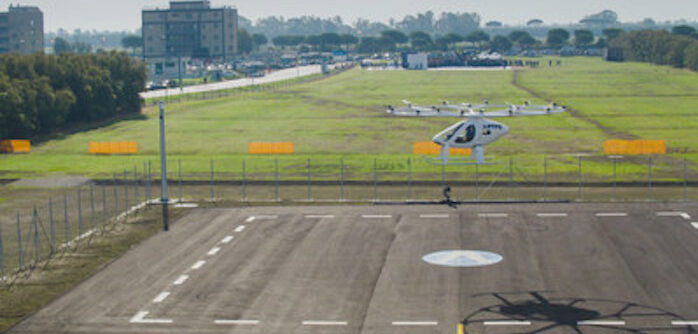Airport operator Aeroporti di Roma (ADR), investment company Atlantia, vertiport designer UrbanV and eVTOL manufacturer Volocopter have successfully completed the first crewed eVTOL (electric vertical take-off and landing) test flights in Italian airspace as part of a mobility ecosystem setup at Fiumicino Leonardo da Vinci International Airport.
According to the companies, this is a key milestone toward the envisioned rollout of advanced air mobility (AAM) services in Rome by 2024, with the partners having initiated operations of the first fully functional vertiport in Italy.
Volocopter’s test pilot aboard the electric Volocopter 2X flew 40km/h for five minutes at a height of 40m along a ‘figure 8’ flight path in front of onlookers after attaining all the necessary clearances from the Italian authorities, the civil aviation authority (ENAC) and the provider of air traffic control services, whose role stays central in shaping the future AAM ecosystem.
The vertiport is developed in compliance with the European Union Aviation Safety Agency’s (EASA) Prototype Technical Specifications for the Design of VFR Vertiports for Operation with Manned VTOL-Capable Aircraft Certified in the Enhanced Category and is located within the Regulatory Sandbox approved by ENAC. It is designed to host various types of tests for both flight and ground operations (turnaround, battery charging, etc), with an electric system devised to allow testing of various eVTOL charging technologies (battery swaps, fast charging, etc).
The infrastructure, occupying an area of about 5,500m2 , has been sized to ensure compatibility with the main eVTOLs that will be certified in the coming years and consists of a final approach and takeoff area (FATO) for landing and takeoff operations, a parking area, a covered hangar measuring 20 x 20 x 6m, and various rooms, including an office, a warehouse and an area for battery charging.
The flight on October 6 was followed by a vertiport demonstration hosted by UrbanV, a company established by ADR together with Aéroports de la Côte d’Azur, Aeroporto di Venezia (SAVE) and Aeroporto Guglielmo Marconi di Bologna. The aim is to design and build vertiports internationally. In this context, another dimension of future AAM services was explored, the VoloIQ. This digital platform is the backbone of the urban air mobility ecosystem, supporting digital access to all working process.
“One of the pillars of Atlantia’s new industrial strategy is investment in technology and innovation to make our assets increasingly sustainable and to open up new forms of integrated mobility,” said Giampiero Massolo, president of Atlantia. “We are pleased to have helped bring together a number of companies in which we are shareholders. By working together and contributing to a range of expertise and areas of excellence, we are creating a new kind of sustainable mobility that did not exist until a few months ago. By collaborating with the related institutions, we aim to open up the service to the public at Fiumicino, before extending it to the other airports in which we have invested by 2024.”
Marco Troncone, CEO of Aeroporti di Roma, added, “Today’s event represents a significant milestone in our path as pioneers in testing and implementing advanced air mobility in Italy, and in playing our part in making urban transport increasingly sustainable and seamless. The opening of the first vertiport in Italy and the first crewed eVTOL flight represent a remarkable step toward the activation of the first AAM routes between Fiumicino Airport and Rome city center by the end of 2024, ahead of the [Catholic] Jubilee, to offer our contribution to our city and our institutions in welcoming the international tourist flows with a groundbreaking, innovative service.”


